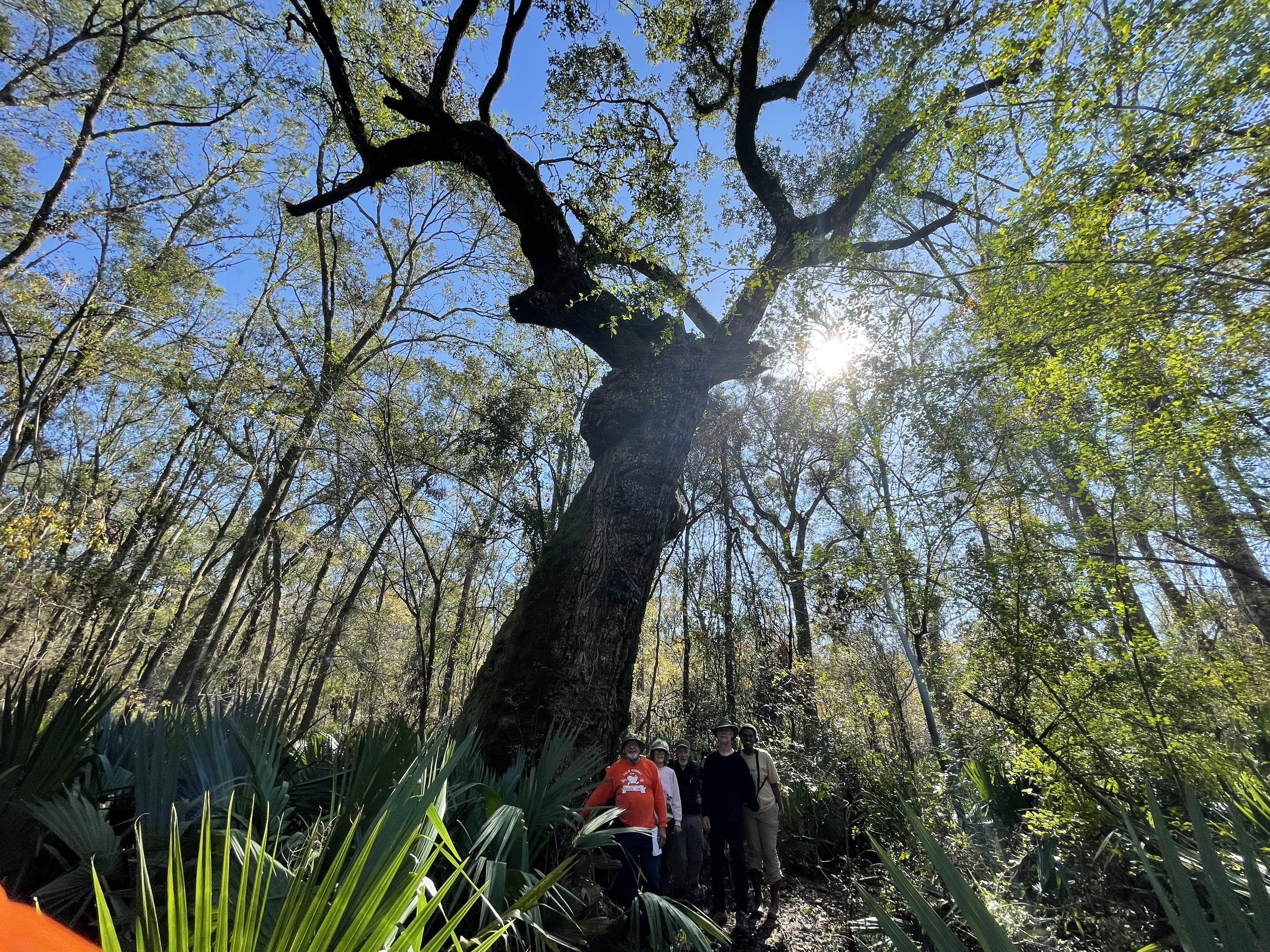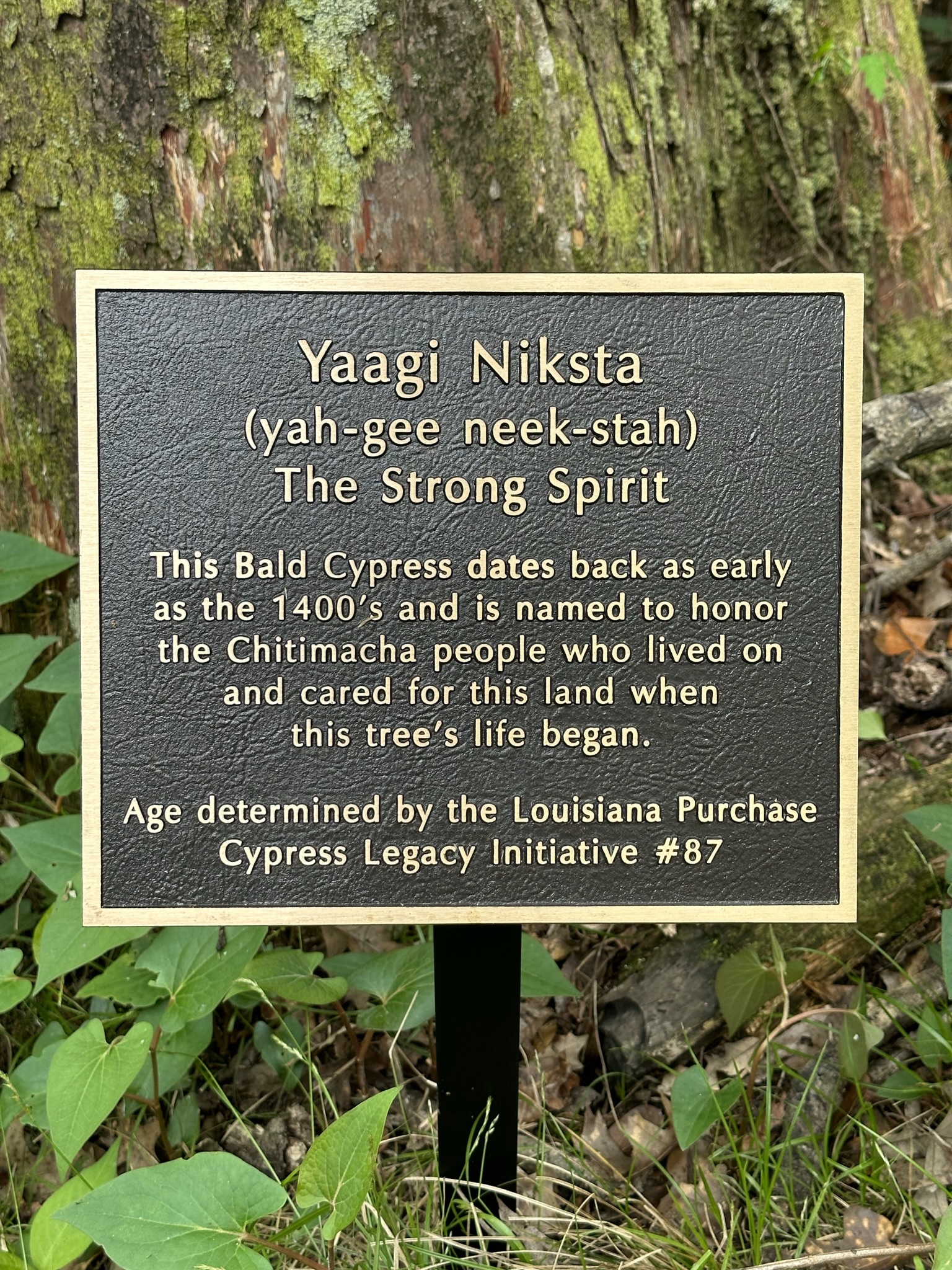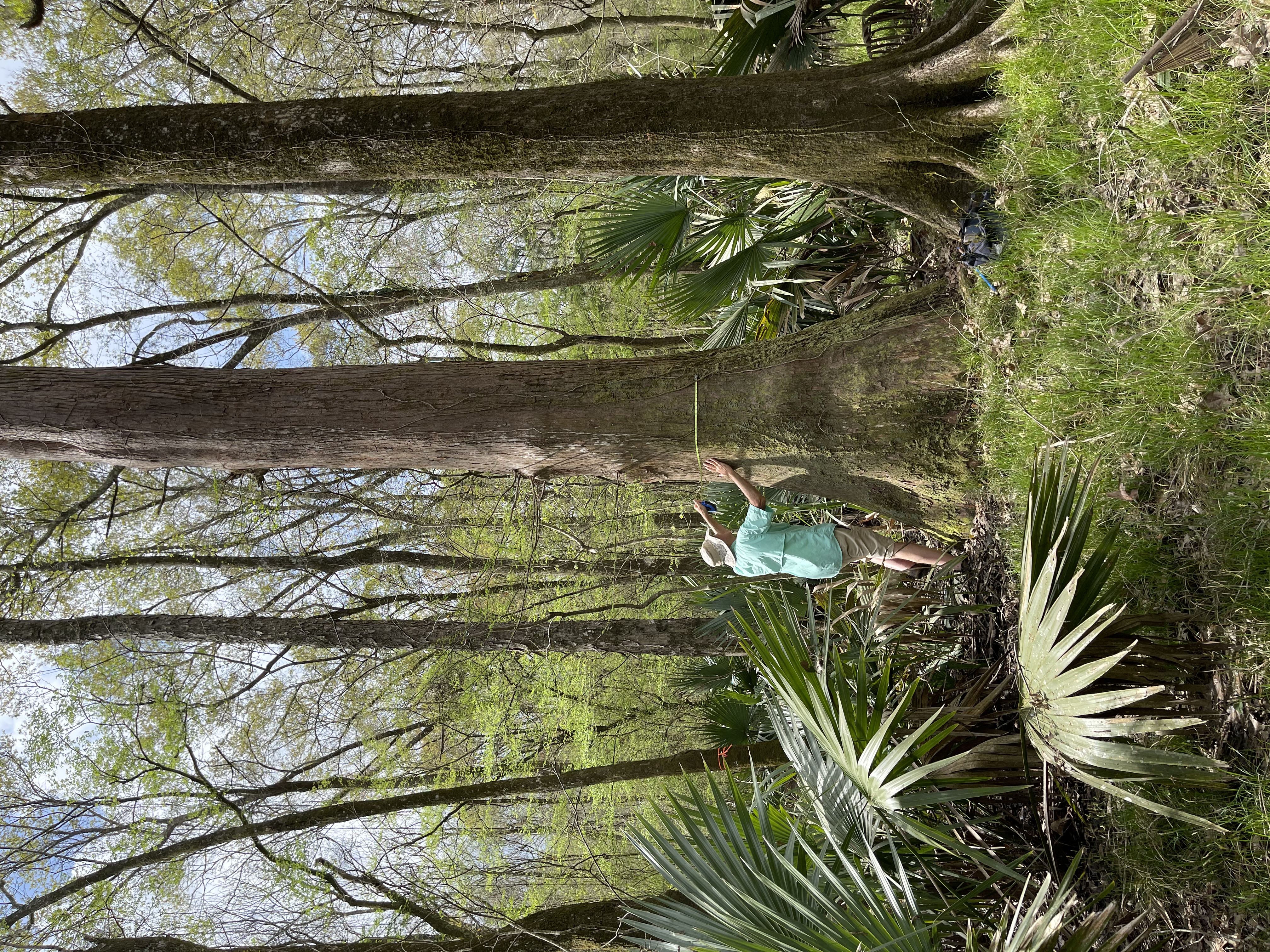Naming of the Trees
Naming the Legacy Trees
by Jane Patterson
 As the BR Audubon Amite River Wildlife Sanctuary property was explored, it was discovered that there are ancient trees on the property. There is a bald cypress tree that was dated by the Louisiana Purchase Legacy Cypress project to be between 400 and 600 years old, dating to as far back as the early 1400's. The legacy live oak, in the heart of the sanctuary, judging by its size, would likely be between 350 and 400 years old, dating back to the early 1600's. Both pre-date the European settlers to the area, which made us wonder which indigenous peoples might have lived here prior to European colonization. After researching, there were a couple of possibilities, but the Chitimacha tribe inhabited basically what is now called the Atchafalaya river basin. This is one of the 4 sovereign tribes of Louisiana, recognized by the federal government, and the only one still living on their ancestral lands, though their reservation is significantly south of Ascension parish in Charenton LA. I contacted the Chitimacha museum to ask about translating a couple of words to use as names for our legacy trees so that I could tie in this cultural significance to our sanctuary site. When I asked for these translations, I didn't imagine it was a big deal as I was just asking for translations for what I supposed were fairly common words. First, formal permission had to be requested and granted by the tribal council, which was done. But I still didn't get an answer right away. As circumstances would have it, I ended up not far from the museum in Charenton several weeks after I'd made the request, so I decided to stop by and ask about it. Theresa, who greeted me, asked if I'd like the museum tour. She said the tour started with a film. As the film began, I realized that the simple request to translate a few words from English to the Chitimacha language was far from simple. The film was all about the fact that their language had been, in fact, extinct. The last speakers died in 1940. However, a linguist from the Smithsonian Institute had come to their village in the 1930's and recorded over 200 hours of language from that last two native speakers. The recordings were on wax spools and were very scratchy and often garbled, but at least it was something. Over a decade ago, the tribe began the effort to reclaim their language. They worked with Rosetta Stone to create a language learning series that is now used in schools and for their adult tribe members. They start teaching Chitimacha as young as nursery school and throughout all grades in their school. They are trying to reclaim and preserve their heritage through their language.
After the tour, it was explained to me that they were having trouble with the translations of one of the words I'd asked for and that's why the response to the request was taking so long. She said they were working on it and hoped to have an answer soon.
Shortly after this visit, I received that answer.
For the legacy cypress tree, I'd asked for the translation for "strong spirit". In Chitimacha, that is Yaagi Niksta (pronounced Yah-Gee Neek-Stah [hard "G"]. This tree has indeed had a strong spirit to have lived for as many as 600 years.
For the legacy live oak tree, I'd asked for the translation of "heart" because this tree is in the heart of our sanctuary, the branches look like a heart and it also has had a lot of heart to survive in the middle of the swamp where a live oak really doesn't even belong. The translation is Puxna ( pronounced Poosh-Nah), our Heart Oak.
As the BR Audubon Amite River Wildlife Sanctuary property was explored, it was discovered that there are ancient trees on the property. There is a bald cypress tree that was dated by the Louisiana Purchase Legacy Cypress project to be between 400 and 600 years old, dating to as far back as the early 1400's. The legacy live oak, in the heart of the sanctuary, judging by its size, would likely be between 350 and 400 years old, dating back to the early 1600's. Both pre-date the European settlers to the area, which made us wonder which indigenous peoples might have lived here prior to European colonization. After researching, there were a couple of possibilities, but the Chitimacha tribe inhabited basically what is now called the Atchafalaya river basin. This is one of the 4 sovereign tribes of Louisiana, recognized by the federal government, and the only one still living on their ancestral lands, though their reservation is significantly south of Ascension parish in Charenton LA. I contacted the Chitimacha museum to ask about translating a couple of words to use as names for our legacy trees so that I could tie in this cultural significance to our sanctuary site. When I asked for these translations, I didn't imagine it was a big deal as I was just asking for translations for what I supposed were fairly common words. First, formal permission had to be requested and granted by the tribal council, which was done. But I still didn't get an answer right away. As circumstances would have it, I ended up not far from the museum in Charenton several weeks after I'd made the request, so I decided to stop by and ask about it. Theresa, who greeted me, asked if I'd like the museum tour. She said the tour started with a film. As the film began, I realized that the simple request to translate a few words from English to the Chitimacha language was far from simple. The film was all about the fact that their language had been, in fact, extinct. The last speakers died in 1940. However, a linguist from the Smithsonian Institute had come to their village in the 1930's and recorded over 200 hours of language from that last two native speakers. The recordings were on wax spools and were very scratchy and often garbled, but at least it was something. Over a decade ago, the tribe began the effort to reclaim their language. They worked with Rosetta Stone to create a language learning series that is now used in schools and for their adult tribe members. They start teaching Chitimacha as young as nursery school and throughout all grades in their school. They are trying to reclaim and preserve their heritage through their language.
After the tour, it was explained to me that they were having trouble with the translations of one of the words I'd asked for and that's why the response to the request was taking so long. She said they were working on it and hoped to have an answer soon.
Shortly after this visit, I received that answer.
For the legacy cypress tree, I'd asked for the translation for "strong spirit". In Chitimacha, that is Yaagi Niksta (pronounced Yah-Gee Neek-Stah [hard "G"]. This tree has indeed had a strong spirit to have lived for as many as 600 years.
For the legacy live oak tree, I'd asked for the translation of "heart" because this tree is in the heart of our sanctuary, the branches look like a heart and it also has had a lot of heart to survive in the middle of the swamp where a live oak really doesn't even belong. The translation is Puxna ( pronounced Poosh-Nah), our Heart Oak.
Many thanks to the Chitimacha Indian tribe for their approval of my request and assistance with these translations!
Due to overwhelming support I was able to get plaques for each of these trees that properly honors them. Thank you again to everyone who donated!
